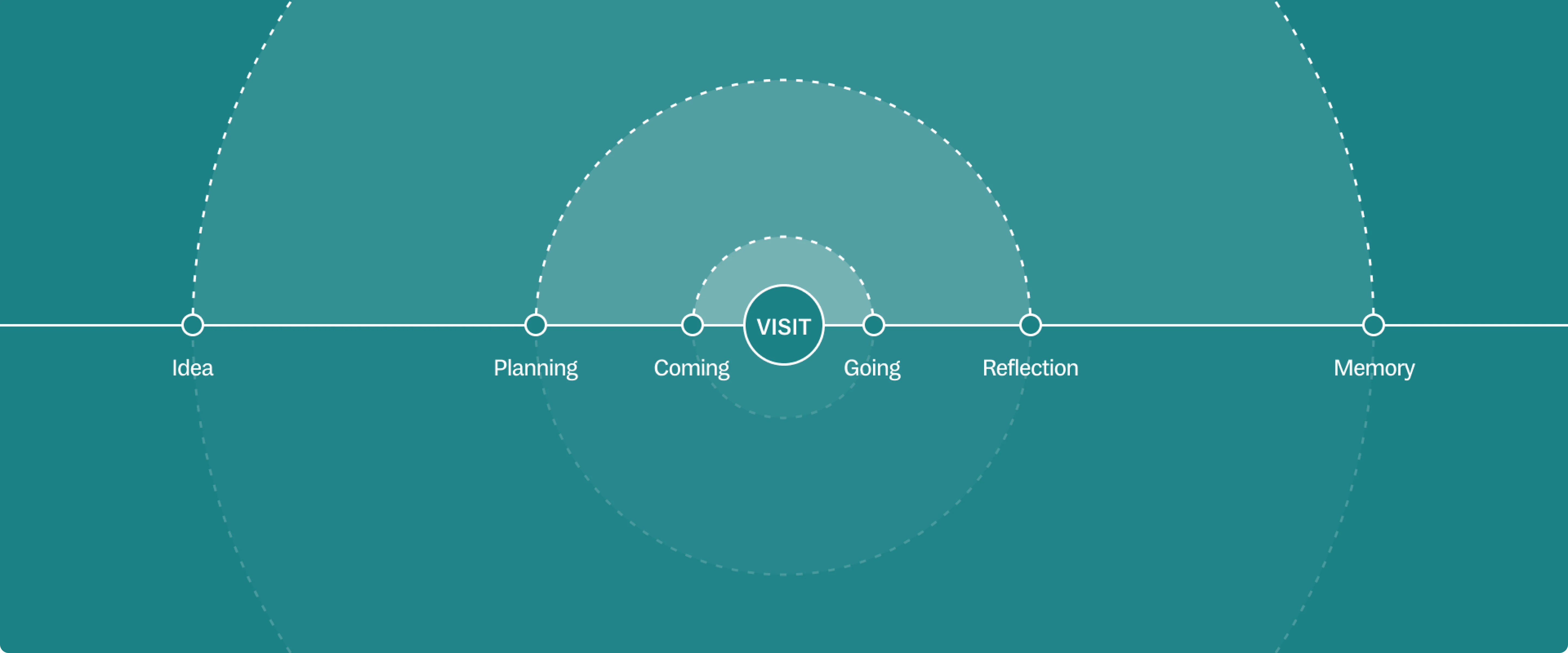
Waypoints, not endpoints
How cultural institutions can meet audiences where they are

False binaries
The most impactful institutions aren’t asking digital or physical, offsite or onsite, pre or post visit—they’re asking how do we meet our audiences wherever they are?
The future of engagement lies in a more porous museum experience—one that fluidly blends indoors and outdoors, digital and physical, arrival and departure. It’s not about choosing between these—it's about designing a continuum that connects them.
As part of broader placemaking initiatives, we see cultural centers experimenting with hybrid formats. Think of an institution that offers a mobile guided walking tour of local street art, ending at a contemporary exhibition on urban expression. The experience starts outside and away from the venue—but the story flows seamlessly through both spaces.
At Pladia, we help institutions to improve visitor experiences across the full visitor lifecycle—before, during, and after the visit. What we see time and again is that visitors don't separate their in-venue experience from the time they spend browsing online beforehand, planning their itineraries, or how they share their visit with friends and family afterwards. They don’t separate their digital touchpoints from their physical experience. And yet, many institutions still do.
This is largely because digital investments often reflect an outdated model:
- Marketing owns the offsite experience
- Curatorial owns the onsite experience
- And the post-visit phase can often fall through the cracks.
The result isn’t just operational inefficiency—it’s a missed opportunity to build lasting engagement. Research and analysis from IMPACTS Experience notes that curatorial staff determine what’s important for visitors, but it’s potential visitors who determine if that is actually relevant to them. And that intersection between importance and relevance is where marketing and digital engagement can be used to motivate visitors to move from offsite to onsite.
If you’re not intentionally designing for offsite moments of engagement, you’re leaving meaning, memory, and momentum on the table.
Learnings from the post-visit experience
In recent research conducted by Pladia’s Lead UX Designer, Madeleine van Venetie, she uncovered what actually happens after a visit.
Four key takeaways from Pladia’s research:
- Visitors want to reflect on their experience—but rarely find the time.
They take photos, collect catalogues, and say they plan to revisit what they learned. But without intentional prompts or support, those good intentions fade within days. - Photography is the primary tool visitors use to mark what mattered.
It’s not just about social media—it’s about memory, emotion, and personal connection. - Timing is critical.
The first 48 hours post-visit are crucial. Beyond that, momentum is lost. - Personalization matters.
Generic content falls flat. Visitors respond best to things that reflect their visit—their photos, their interests, their moments.
These are not just insights about memory—they’re insights about design. If museums want to extend the impact of their onsite experiences, they must actively design for what happens before and after. At Pladia, we use these insights to inform every feature: guiding institutions to support engagement, memory, and connection when it matters most.
Designing intentionally connected journeys
We believe visitor journeys don’t begin at the entrance—or end at the exit.
With beacon-free wayfinding, dynamic interpretive content, seamless outdoor to indoor transitions, and accessibility tools, Pladia helps institutions design for what happens before the first engagement with a collection and after the final stop.
We believe technology should provide utility and invite deeper connection—not distract from "eyes-up" moments. That’s why we use visitor-centered design principles: frictionless access, meaningful interaction, and visitor choice.
The way we measure success at Pladia is different from many others. We aren’t looking for increased screen time as a measure of whether we’ve created an improved visitor experience. Instead, we want to help visitors find what they’re looking for, enjoy a museum visit that matches their interests, and discover meaning along the way.
Unify your experience strategy across departments
Break down the operational silos that separate marketing, curatorial, digital, and visitor experience. A holistic visitor journey demands shared goals and collaborative design.
Leverage visitor-generated content
People are already capturing photos, reflections, and stories. Build systems that celebrate and resurface this—timely, lightweight, and relevant to their individual experience.
Start with the moment of exit
Think of the last five minutes as a new starting point. It’s your launchpad for sustained engagement. What do visitors take with them—physically, emotionally, digitally?
The most meaningful experiences don’t start or stop at the venue door. When we treat onsite and offsite, physical and digital, not as endpoints, but as waypoints on a continuous journey, we unlock new possibilities for connection, inclusion, and meaning.
At Pladia, we help institutions bring this journey to life —before, during, and after the visit. Because when we design holistically, we don’t just connect more dots.
We connect more people—more deeply, and more meaningfully—with culture itself.